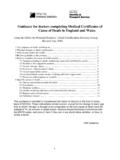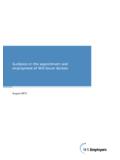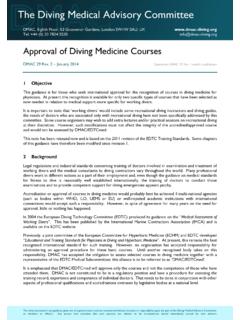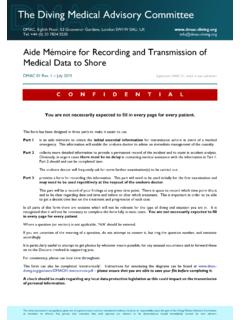Transcription of The Fit Note - GP Guidance - Barnet, Enfield and …
1 Getting the most out of the fit noteGP guidanceBased on research evidence and feedback from doctors , patients and employers, this guide is designed to help you make best use of the fit note to support your gives you information on completing each section of the fit note (including the reassessment box, comments section and return to work tick boxes), and uses case studies to illustrate different updates previous Guidance , reflects new developments such as computer-generated fit notes and has an expanded further support section. You can also use it for Continuing Professional Development and revalidation has been developed in consultation with practising doctors and professional bodies including: Acas British Medical Association Confederation of British Industry Royal College of General Practitioners EEF - the manufacturers organisation Chartered Institute of Personnel and Development3GP guidanceThis guide can be read through in order, or you can refer to specific sections independently as follows: Key messages 3 How the fit note can help you 4 What is the evidence behind the fit note 6 and this guide?
2 Do you need to issue a fit note? How to 8 assess a patient s fitness for workFilling in the fit note: instructions 10 for completion Giving advice in the fit note 12 the tick boxes and the comments box How your patient will use their fit note 14 The fit note in action best practice 15 case studiesAdditional questions 19 Further information and support 22 CPD reflective note Guidance and template 25 Your assessment about whether your patient is fit for work is about their fitness for work in general and is not you assess that your patient s fitness for work is not impaired by a health condition, they are fit for work and do not need a fit note. Always consider if your patient could do work of some kind before advising that they are not fit for work. Remember to consider carefully whether advising your patient that they are not fit for work increases the long-term health risks of should use the fit note to give advice about the functional effects of your patient s condition on their fitness for work in are not expected to have specialist knowledge of workplaces or occupational health, and you do not need to suggest possible changes to your patient s workplace or should tick whichever return to work boxes relate to your advice, and consider using the comments box to give further you do have specialist occupational health knowledge you can go into further detail about possible adaptations if you think this would help.
3 Key messages4 Getting the most out of the fit note How the fit note can help you The fit note can be a key tool for you to use to improve your patient s health and be an advocate for their benefits of using the fit note to its full potentialThe fit note is designed to help you provide fitness for work advice to your patients. This guide will help you use the fit note to its maximum potential to improve your patient s health and wellbeing. In particular, using the fit note to its full potential enables you to: Effectively manage your patient s expectations about their capability for work. Give a clear clinical assessment to your patient about the impact of their condition on their fitness for work. Improve the likelihood of your patient keeping their job, by helping them to discuss ways they could be supported at work with their employer. Support the vital role that work can play in your patient s health, as set out in the evidence behind the fit the other hand, incomplete fit notes can make it hard for employers to support your patient and cause unnecessary delays to your patient s return to work (with associated consequences for their health).
4 They can also cause additional work for you as patients ask you for new fit notes when they don t need role of GPsAll GPs are able to provide simple fitness for work advice to aid their patient s recovery and help them return to is then up to your patient and their employer to discuss your advice and consider possible is a general consensus1 that GPs and other healthcare professionals: play a key role in advising patients about (return to) work; agree that (return to) work is an important outcome for clinical management; help patients develop a return-to-work plan; facilitate return to work through communication with patients (so that they can communicate effectively with employers).1. Healthcare Professionals Consensus Statement Statement of Health and Work (2008). In the same way as we encourage healthy eating, healthy living and healthy lifestyle, a healthy attitude to work has always been a part of that.
5 (GP)5GP guidanceSupporting clinical management Return to work is an important contributor to health. The following helps to support effective clinical management for your patients: Discuss fitness for work with your patients. Consider if they may be fit for some work. Complete all relevant sections of the fit note, to provide as much useful advice as possible to your patient and their employer. In particular, complete the comments box with advice on the functional effects of your patient s health condition. Consider your own training needs on health and work, and build your knowledge of other support and fit notesFit notes can be handwritten or computer-generated and printed out. Computer-generated fit notes have the added benefits of: Automatically completing certain parts of the fit note to save you having to fill them in each time you issue one.
6 Ensuring that your advice is easy to read for patients and employers. Removing the need for you to re-write fit notes if duplicates are required, as other staff members can print out duplicate copies. Enabling clinical management and fitness for work advice to be monitored together for patients with long-term conditions. Improving the continuity of patient care generally for example if patients are seen by different GPs. Allowing you to share knowledge and learning points with colleagues in your practice and carry out appropriate internal you do not have access to computer-generated fit notes , speak to your practice s IT provider and ask for information is available at: You might imagine that people would come in wanting a sick note because they want time off work but most of the time that I ve suggested they actually might be fit with adaptations, they re quite open to it, which has surprised me a bit.
7 (GP)6 Getting the most out of the fit note Most importantly, the evidence is clear that patients benefit from being in some kind of regular work. This improves mental and physical health and can aid behind the fit note s principlesPatients are happy for their GP to give them advice on work issues2, and do not feel that this threatens the doctor-patient relationship3. Most GPs agree that work is generally beneficial for health, and that they play an important role in helping patients return to work4. The fit note helps you to discuss work with your work is generally good for physical and mental health5 and people do not have to be 100% fit in order to work in most cases6. The fit note supports people to work when they longer a patient is off work the lower their chances are of making any return to work7. The fit note helps you to support people to return to work as soon as you know, most people with common health problems can be helped to return to work by following a few basic principles of healthcare and workplace fit note allows you to give advice about your patient s health condition and how it can be managed in the communication between GPs, patients and employers leads to faster return to work and people have the best chance of returning to work if the clinical management of their health condition is linked to the workplace9.
8 The fit note captures your advice clearly for your patient and their employer so they can discuss if the employer can make changes to accommodate a return to is the evidence behind the fit note and this guide?The fit note is built on robust evidence, which this guide helps you translate into practical support for your patient. 2. Collingwood, S. (2011). Attitudes to health and work amongst the working-age population DWP Research Report No 763 O Brien et al (2008). Sickness certification in the general practice consultation: the patients perspective, a qualitative study. Cardiff University Hann M and Sibbald B (2011). General Practitioners attitudes towards patients health and work DWP Research Report 733. Waddell, G. and Burton, (2006), Is work good for your health and well-being? TSO Waddell, G., Burton, and Kendall, (2008). Vocational Rehabilitation, what works, for whom and when?
9 TSO Ibid, footnote 58. Ibid, footnote 69. Ibid, footnote 6 Work is useful and it s actually really detrimental if I m just signing people off. (GP) I think work improves people s health if they re in a job that s giving them job satisfaction, income and a routine in their day - it can be very beneficial for most people to go back to work. (GP)7GP guidanceThe fit note so farThe fit note was launched in April 2010 to replace the old sick note. It allows doctors to give more information to patients about the functional effects of their health condition on their fitness for work, to help people return to work where then, our ongoing evaluation programme has helped us understand how we can support doctors , patients and employers to get the most out of the fit note. We have used this research to inform this guide, along with revised Guidance for employers and key themes to emerge were10: Patients told us that the fit note had helped them challenge assumptions from some employers that people with a health condition cannot work, and had empowered them to agree changes with their employer and return to work.
10 Employers wanted more use of the may be fit for work option, so that they could explore whether employees could be supported to return to work. In particular they wanted clearer and fuller information in the comments section about the employees functional capabilities. GPs told us that the fit note had helped patients make a phased return to work. It had helped to guide discussions with patients about fitness for work, including challenging some patients perceptions of their fitness for work. 10. Hann, M. and Sibbald, B. (2011). General Practitioners attitudes towards patients health and work DWP Research Report 733. Fylan, B., Fylan, F. and Caveney, L. (2011). An evaluation of the Statement of Fitness for Work: qualitative research with General Practitioners. DWP Research Report 780. Lalani, M., Meadows, P., Metcalf, H. and Rolfe, H. (2012). An evaluation of the Statement of Fitness for Work: qualitative research with employers and employees.









